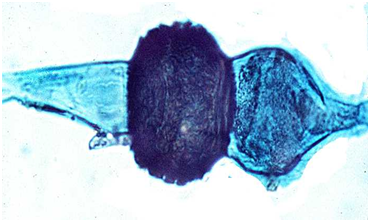Reproduction: Rhizopus stolonifer style
Rhizopus stolonifer exhibits both sexual and asexual reproduction. The asexual phase occurs more frequently. The surrounding condition in which the mold resides, is the factor that causes either type of reproduction by the mold.
Before learning the specifics, click here to view how Rhizopus stolonifer, as a member of the phylum Zygomycota, compares to other phylum within the kingdom of Fungi.
When the mold comes in contact with a substrate, such as bread, it first spreads over the surface and penetrates it while sending hyphae inward to absorb the nutrients. Rhizopus stolonifer grows primarily as mycelia, which consists of long filamentous cells, or hyphae, that lack cross walls, known as septa. The lack of septa enables the mold to be named coenocytic. Coenocytic means that the mold is a multinucleate cell enclosed by one cell wall that contains chitin.
Asexual Reproduction
In asexual reproduction, special non-motile hyphae called sporangiophores produce sporangia that form in an upright fashion. The sporangia at the tips of the upright hyphae develop as bulbous black portions. Branching structures, called rhizoids, anchor the fungus into the substrate, releasing digestive enzymes and absorbing nutrients for the fungus. When conditions are good the sporangia, containing numerous haploid spores of which are produced through mitosis, release the spores into the surrounding atmosphere. These spores then may land on a moist surface and the life cycle repeats.
Side note: Rhizopus stolonifer spores are usually dispersed in hot dry weather and they contain allergic proteins, which can cause respiratory and nasal symptoms in humans, such as coughing, chest discomfort and allergic reactions.
Sexual Reproduction
 In sexual reproduction, resistant spherical spores are
formed, called zygospores. Zygospores are thick-walled, which make
them highly resistant to environmental hardships. The word zygospore comes
from the Greek word zygos, which means joining. The zygospores are the only
diploid phase of Rhizopus stolonifer reproduction. They are composed
of two suspensor cells, which are the former gametangia or hyphae. There is
a suspensor cell on either side of a large, rough, dark brown spore. The
suspensor cells are present to provide support. The zygospore forms from two
special haploid hyphae of opposite mating types that touch due to hormones
and being in close proximity of each other. The two cytoplasms intermingle,
also known as plasmogamy. As this occurs the nuclei of both parents
enter the conjunction, causing the resting spore to develop. Karyogamy is the
term used to describe the fusion of the two nuclei. After the zygospore has
fully formed, meiosis occurs and haploid spores are formed and dispersed.
The zygospore can become dormant for several months at a time. Meiosis still
occurs and a sporangium similar to the asexually produced sporangium is
created when the zygospore finally cracks open.
In sexual reproduction, resistant spherical spores are
formed, called zygospores. Zygospores are thick-walled, which make
them highly resistant to environmental hardships. The word zygospore comes
from the Greek word zygos, which means joining. The zygospores are the only
diploid phase of Rhizopus stolonifer reproduction. They are composed
of two suspensor cells, which are the former gametangia or hyphae. There is
a suspensor cell on either side of a large, rough, dark brown spore. The
suspensor cells are present to provide support. The zygospore forms from two
special haploid hyphae of opposite mating types that touch due to hormones
and being in close proximity of each other. The two cytoplasms intermingle,
also known as plasmogamy. As this occurs the nuclei of both parents
enter the conjunction, causing the resting spore to develop. Karyogamy is the
term used to describe the fusion of the two nuclei. After the zygospore has
fully formed, meiosis occurs and haploid spores are formed and dispersed.
The zygospore can become dormant for several months at a time. Meiosis still
occurs and a sporangium similar to the asexually produced sporangium is
created when the zygospore finally cracks open.
Here is an example of the sexual life cycle of Rhizopus stolonifer.
Note: Rhizopus nigricans is a synonym for Rhizopus stolonifer.
To learn about another fungus that has a similar life cycle as Rhizopus stolonifer, please go to Aspergillus fumigatus.
Proceed on to learn about the interactions Rhizopus stolonifer has with other things.


